

| Circe
| Wednesday, March 3, 2010 I began with the engine controls. I'd also planned to install the cockpit-mounted manual bilge pump, but discovered that I had the incorrect cover plate in stock, so I put that project off till the correct part arrived. The owner chose to mount the engine controls as far aft as possible to keep them away from the "passenger" end of the cockpit (i.e. the forward end). Because of the fuel tank mounted to starboard, this limited the position to the port side, near the aft end of the cockpit locker. This location worked out well, as there was good access to the back of the area, and plenty of room for the control mechanism. I chose the Vetus "Sisco" single-lever control for the job. |
|
After considering how the control would lay out, I determined that I needed to mount it sideways to allow for the proper cable run and clearance. With this determined, I masked off an area of the cockpit well in way of the proposed cutout and taped the supplied cutout template in place, adjusting things till I was happy with the location. Then, I cut out the opening as required and test-fit the control. |
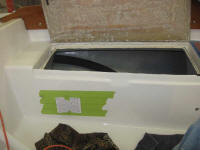
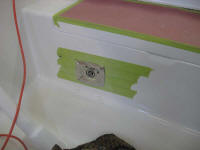 |
|
Next, I secured the pieces and parts required to attach the engine control cables, after determining the correct orientation and connection points of the two cables to provide the operation required: "pull" for throttle advancement, and "pull" for forward gear--("push for reverse"). I secured the two cables to their respective mounting points on the control and on the engine, and permanently mounted the control. |
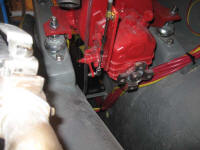

  |
|
Now that the controls were in place and the cables run, I had a better sense of the clearances required beneath the engine for the exhaust hose--most notably the area beneath the transmission shift lever, which extended rather far down when put in reverse. With the cable pushing the lever to its fullest extent, I determined that a slight change in the path of the exhaust hose, and a strategically-mounted clamp or two, would allow the hose to remain clear of the lever, as well as clear of the transmission and eventual shaft coupling. Therefore, I decided to complete the exhaust installation. Beginning at the aft end, at the transom outlet, I secured the hose in place, forming a vertical loop as high as possible within the confines of the lazarette. I secured the hose here with a wire tie and clamp. |
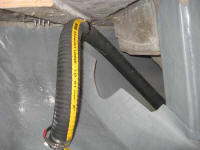 |
|
I ran the forward end of the hose just inboard of the cockpit scupper seacocks and forward beneath the engine, allowing the excess to extend down into the bilge for the moment while I secured the hose in a couple other places along the way. |
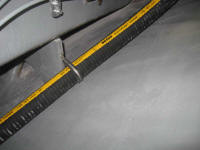 |
|
I cut the forward end of the hose to length and secured it to the waterlift muffler; I marked and sanded a couple placed on the hull and engine foundation where I wished to install cable clamps to better secure the hose later, but I'd wait till the end of the day to glue those in place. With the outlet hose complete, I cut and fit the shorter hose running between the exhaust manifold and the waterlift muffler. Simply because it was how the hose wanted to run, but also to allow clearance for the shaft and coupling, and also to bring the hose forward along the opposite side of the engine--the starboard side--I looped it around aft of the engine, then connected the end to the inlet on the muffler. I secured all the hose ends with double hose clamps as required by governing bodies, and secured the hoses hither and thither to hold them in place and prevent chafe. |
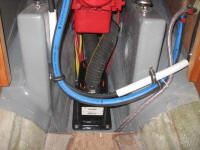
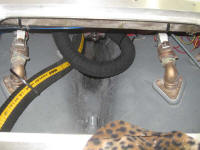 |
|
Finally, I installed a bronze vented loop inside the port cockpit locker, connected to the exhaust manifold and elbow with hoses as required. |

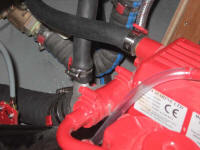 |
|
I rounded out the day with a number of odd jobs, including installing several bronze bolts through the mast beam and bulkhead to further secure these critical members together: I'd been waiting till all the varnish and trim work was complete. |
 |
|
Preparing for the mast wiring, I located a position for a through hull fitting through the deck, through which the mast wiring would eventually run; we planned to abandon the old mast step-mounted conduit through which the wires had run previously. I located the new hole forward of the main bulkhead, in the head, where it'd be the most unobtrusive. With the location chosen, I drilled a hole for the 1-1/8" stainless steel through hull that I had for the job, reamed away the core from the opening, and filled the resulting void with epoxy, leaving it overnight to cure. |
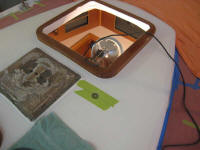 |
|
Finally, I sanded and varnished the companionway trim, and some of the new trim in the galley as needed. |
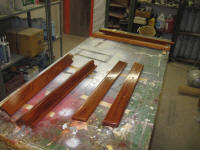 |
|